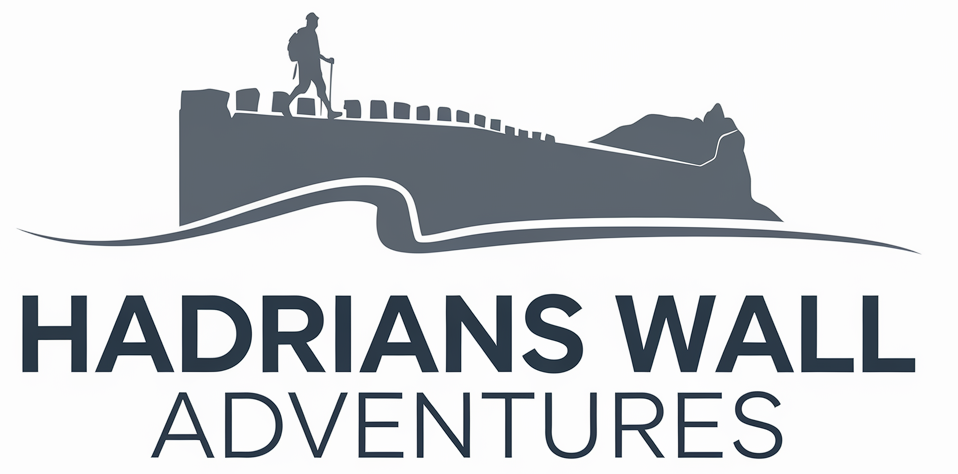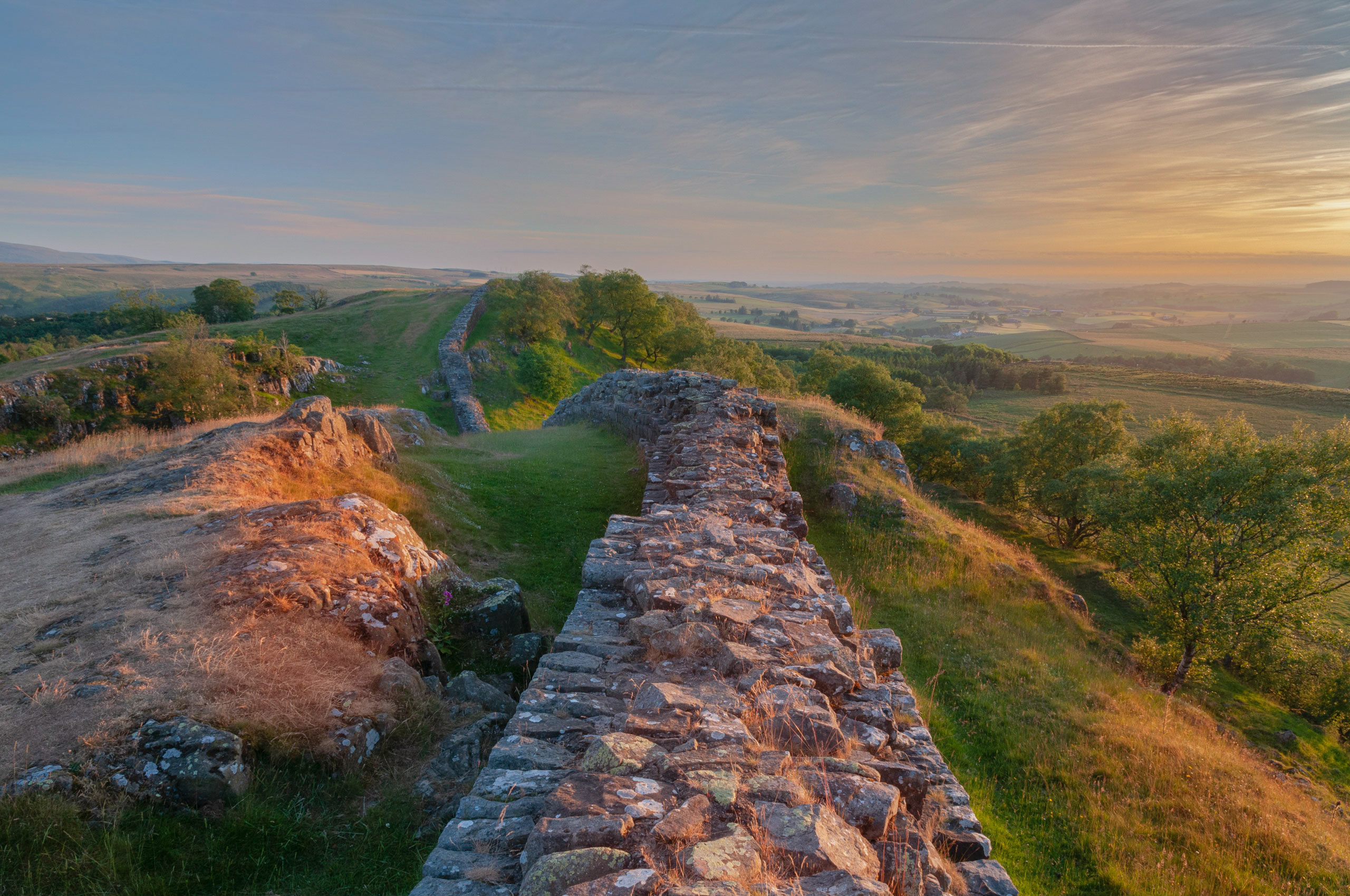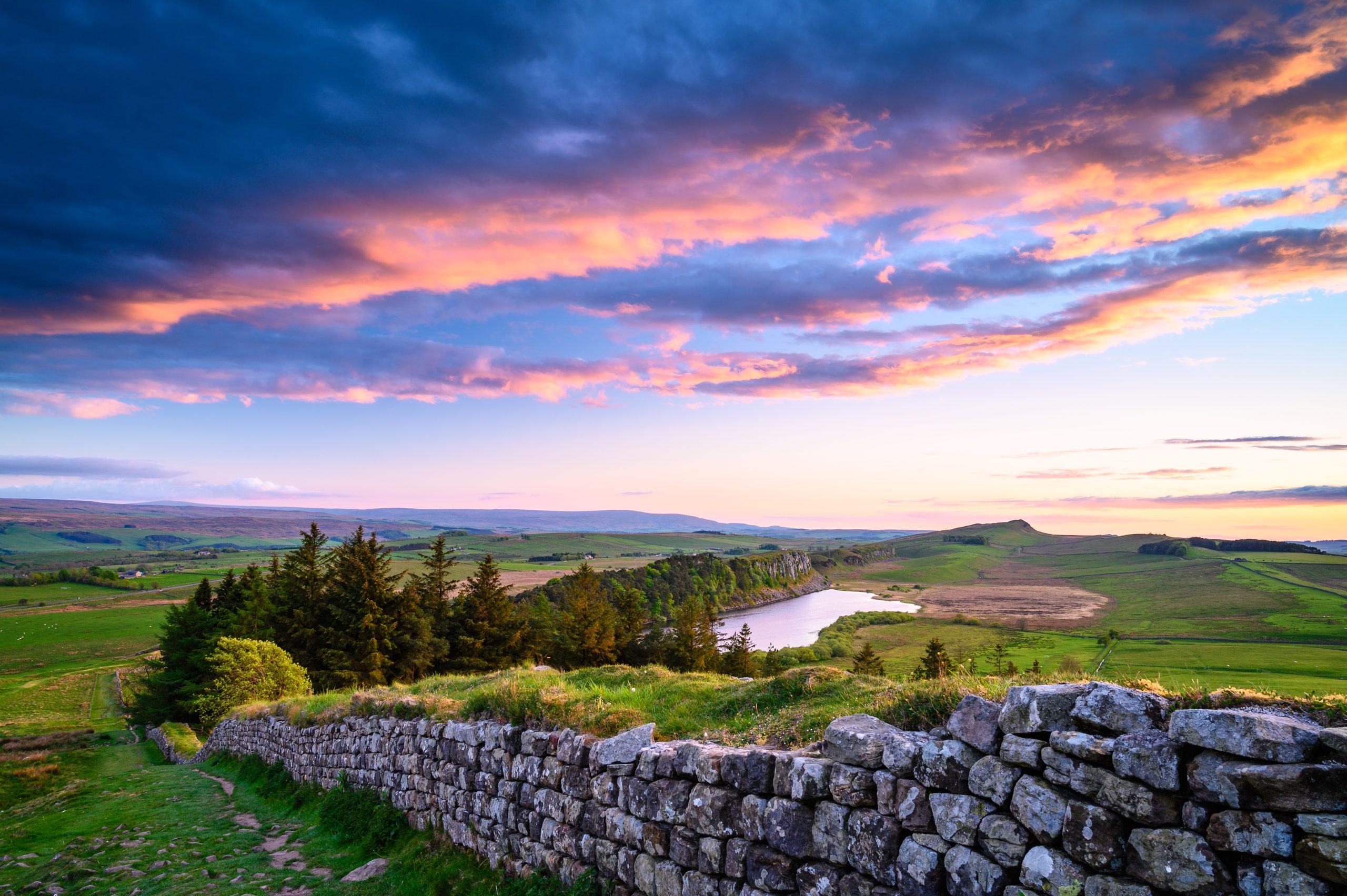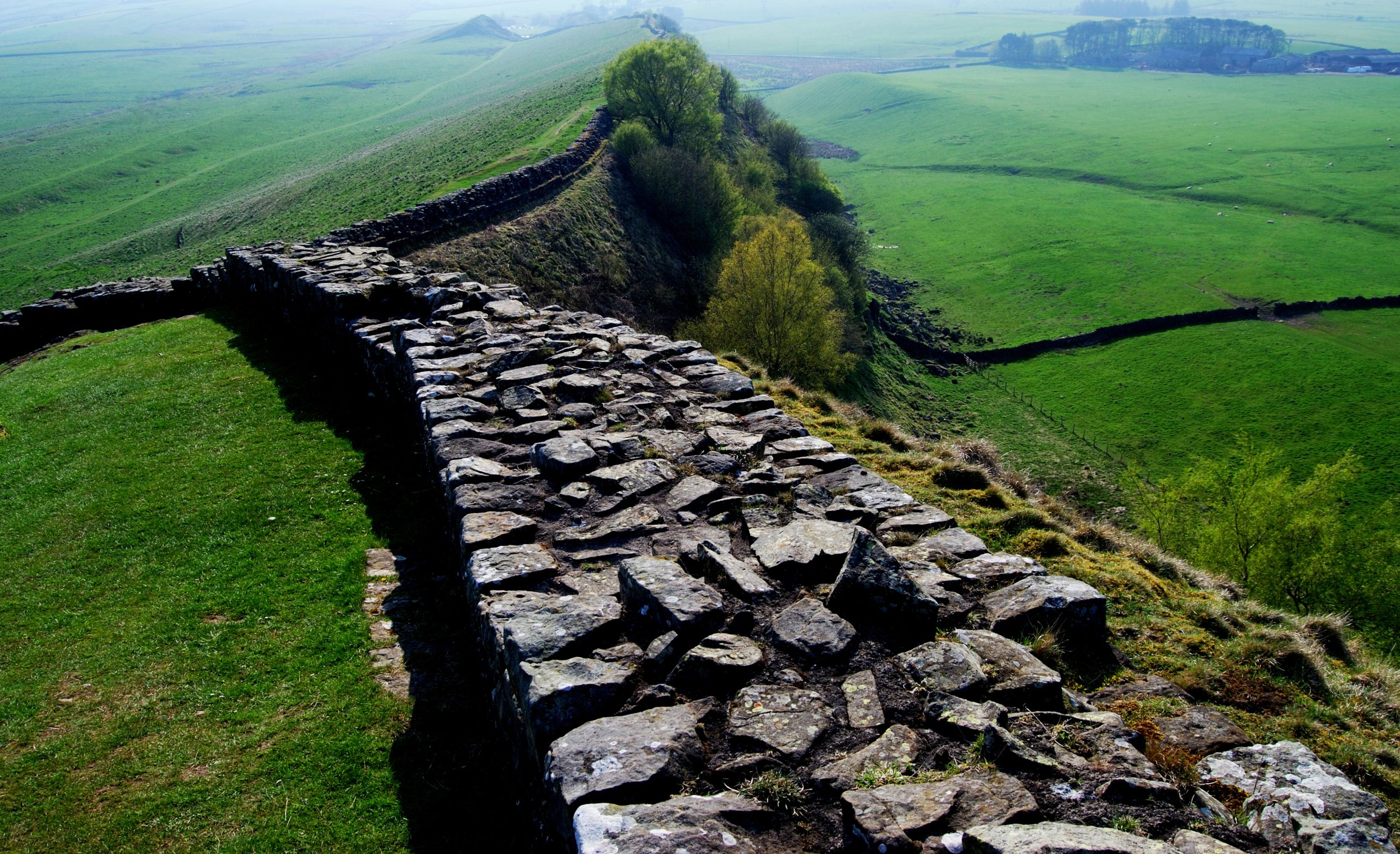- Hadrian’s Wall stretches 73 miles across northern England, featuring some of Britain’s most impressive Roman archaeology
- Ten exceptional sites offer everything from towering fort walls to preserved bathhouses and fascinating museum collections
- The central section between Chollerford and Birdoswald provides the most dramatic scenery and best-preserved Roman remains
- Most sites lie directly on or within easy reach of the Hadrian’s Wall Path National Trail
- Spring through autumn offers the best conditions for exploring these ancient monuments on foot
- Self-guided walking holidays allow flexible time to explore each site thoroughly without rushing
Walking Through Two Millennia of History
Hadrian’s Wall stands as the Roman Empire’s most ambitious frontier monument in Britain. Built from AD 122 onwards under Emperor Hadrian’s orders, this 73-mile stone barrier once marked the northernmost edge of Roman civilisation. Today, walkers following the Hadrian’s Wall Path encounter a remarkable concentration of archaeological sites that bring this ancient world vividly to life.
The wall’s central section, running through Northumberland’s dramatic landscape, preserves the finest Roman remains. Here, rolling hills showcase long stretches of original stonework, while excavated forts reveal the daily routines of soldiers stationed on this remote frontier nearly 2,000 years ago.
Housesteads Roman Fort (Vercovicium)
Perched on a dramatic escarpment overlooking the Northumbrian countryside, Housesteads remains Britain’s most complete Roman fort. The stone foundations reveal an entire garrison town, from the commanding officer’s residence to the communal latrines that still fascinate visitors.
The fort housed around 800 infantry soldiers, and walking through the barracks blocks provides genuine insight into military life on the frontier. The hospital building, granaries, and headquarters demonstrate the Romans’ sophisticated approach to frontier management. Outside the fort walls, the remains of a civilian settlement show how traders and families clustered around military installations.
The views from Housesteads are spectacular. Standing by the fort’s north gate, walkers look across the same landscape that Roman sentries monitored for threats. The wall itself snakes eastward and westward along the ridge, creating one of Britain’s most photographed vistas.
Distance from path: Located directly on the Hadrian’s Wall Path Allow: 2–3 hours for thorough exploration
Vindolanda
Whilst Vindolanda lies slightly south of Hadrian’s Wall itself, no walking holiday would be complete without visiting this extraordinary site. Active archaeological excavations continue to unearth remarkable finds, making each visit potentially different from the last.
The fort’s waterlogged conditions preserved organic materials that normally decay, including the famous Vindolanda writing tablets. These thin wooden sheets, covered in ink correspondence, provide intimate glimpses into Roman frontier life—birthday party invitations, shopping lists, and military reports.
The reconstructed sections at Vindolanda help visitors understand Roman architecture. Full-scale replicas of timber buildings and a stone turret demonstrate construction techniques, whilst the museum houses an exceptional collection including leather shoes, textiles, and personal items.
Distance from path: 1.5 miles south of the main trail Allow: 3–4 hours including museum
Chesters Roman Fort (Cilurnum)
Situated beside the River North Tyne, Chesters guarded a crucial bridge crossing. The fort specialized in cavalry, and its layout differs from infantry installations. The spacious barracks accommodated both soldiers and their horses, whilst the commanding officer enjoyed a luxurious bathhouse that remains remarkably intact.
The bathhouse at Chesters ranks among Britain’s best-preserved Roman structures. Visitors can trace the progression through changing rooms, cold plunge pools, warm rooms, and hot chambers. The underfloor heating system (hypocaust) is clearly visible, showing Roman engineering expertise.
The on-site museum, housed in a Victorian building, contains an impressive sculpture collection including altars, inscribed stones, and decorative reliefs recovered from the site and surrounding area.
Distance from path: Adjacent to the trail at Chollerford Allow: 2 hours
Birdoswald Roman Fort (Banna)
Occupying a commanding position above the River Irthing gorge, Birdoswald offers exceptional views across the Cumbrian landscape. This fort’s exposed stonework clearly shows the construction phases, from Hadrian’s original wall through later modifications.
The site particularly illuminates the transition from Roman to post-Roman Britain. Evidence suggests the fort remained occupied long after official Roman withdrawal, with timber halls built over earlier stone structures. This continuity of occupation makes Birdoswald unique amongst Hadrian’s Wall forts.
Walking the fort’s perimeter reveals well-preserved stretches of wall, a functioning Roman gateway, and extensive earthwork defences. The visitor centre provides excellent interpretation, whilst the farm café offers refreshments with panoramic views.
Distance from path: Directly on the Hadrian’s Wall Path Allow: 1.5–2 hours
Corbridge Roman Town (Corstopitum)
Unlike the military forts along the wall, Corbridge developed as a substantial supply base and civilian settlement. The remains reveal a sophisticated town with stone buildings, workshops, and evidence of considerable wealth.
The Corbridge Hoard, discovered in 1964, contained Roman military equipment including armour pieces buried for safekeeping. The site museum displays this remarkable find alongside everyday objects that illuminate Roman-era commerce and craftsmanship.
Stone streets, fountain bases, and granary buildings demonstrate urban planning, whilst inscribed stones reference various military units stationed here. The site’s layout helps visitors understand how Roman settlements functioned beyond purely military purposes.
Distance from path: 2.5 miles south of the main trail near Corbridge village Allow: 2 hours
Sewingshields and the Wall’s Best-Preserved Sections
Between Housesteads and Steel Rigg, walkers traverse the most visually spectacular section of Hadrian’s Wall. Here, the wall follows the dramatic Whin Sill escarpment, rising and falling across rugged terrain. Several stretches stand multiple courses high, showcasing original Roman stonework.
Sewingshields Crags offers particularly atmospheric walking. The wall snakes along the ridgeline, with milecastles and turrets appearing at regular intervals. These smaller installations housed patrol groups who monitored the frontier between major forts.
This section demonstrates why the Romans chose this route. The natural defensive position reduced the need for massive fortifications, whilst commanding views allowed early warning of any approaching groups.
Distance from path: This section IS the Hadrian’s Wall Path Allow: Full walking day from Housesteads to Steel Rigg
Steel Rigg and Sycamore Gap
Steel Rigg provides access to one of the wall’s most dramatic stretches. The undulating terrain creates stunning vistas, particularly at sunrise or sunset when low light accentuates the landscape’s textures. Multiple milecastles and turrets punctuate this section, each offering interpretation boards explaining their function.
The area includes Milecastle 39 (Castle Nick), which sits in a natural dip along the ridge, and demonstrates the Romans’ commitment to maintaining regular installations regardless of terrain challenges.
Distance from path: Directly on the trail with car park access Allow: 2–3 hours walking this section
Carvoran Roman Fort and Army Museum
Carvoran, whilst less visually impressive than major forts, houses the Roman Army Museum. This facility provides essential context for understanding Hadrian’s Wall’s military function through interactive displays, reconstructions, and archaeological finds.
The museum’s 3D film demonstrates wall construction, whilst exhibits cover soldier recruitment, training, equipment, and daily routines. For families or those seeking deeper understanding before tackling the wall walk, this museum offers excellent preparation.
The fort itself shows clear outline earthworks, and interpretive panels explain the site’s development. Its position slightly south of the wall proper reflects construction phases when the frontier line shifted.
Distance from path: 0.5 miles south of the main trail Allow: 1.5–2 hours for museum and fort
Haltwhistle and the Roman Military Zone
Haltwhistle serves as an excellent base for exploring multiple Roman sites. The town’s position in the wall’s central section provides access to Vindolanda, Carvoran, and the dramatic wall sections within easy reach.
Several smaller sites around Haltwhistle, including various turrets and milecastles, reward exploration. These less-visited locations often provide peaceful encounters with Roman remains, away from main tourist concentrations.
The surrounding landscape preserves sections of the Stanegate, the road that predated Hadrian’s Wall as the frontier line. Walking these quieter paths reveals how the Romans established infrastructure before undertaking the massive wall construction project.
Great Chesters Fort (Aesica)
Great Chesters occupies a less prominent position than major forts but rewards visitors seeking quieter exploration. The fort’s layout remains clearly visible, and its isolated location provides atmospheric walking conditions.
Evidence suggests Great Chesters had an unusual feature—an underground strong room or vault, possibly for storing military payroll or valuables. The fort’s water supply came via aqueduct from distant springs, demonstrating Roman hydraulic engineering skills.
Distance from path: Short detour from the main trail Allow: 1 hour
Planning Your Roman Wall Adventure
Walking Hadrian’s Wall Path whilst visiting these Roman sites requires realistic planning. Most walkers complete the full 84-mile national trail (which extends beyond the wall’s actual length) over 6–8 days, allowing time for thorough site exploration.
Self-guided walking holidays provide flexibility to spend longer at fascinating locations without group constraints. Many walkers choose to focus on the central section between Chollerford and Birdoswald, where the best sites and scenery concentrate.
Practical Considerations
Weather in Northumberland can change rapidly, even in summer. The exposed sections along the Whin Sill escarpment experience strong winds and reduced visibility during poor conditions. Spring (April–May) and early autumn (September–October) often provide ideal walking weather with fewer crowds.
Most major Roman sites charge admission (English Heritage or independently managed), though wall sections and smaller installations remain freely accessible. English Heritage membership provides excellent value for anyone visiting multiple sites.
Baggage transfer services operate throughout the trail, allowing walkers to explore sites carrying only daypacks. This service proves invaluable when visiting Vindolanda or Corbridge, which require leaving the main path.
Navigation and Facilities
The Hadrian’s Wall Path enjoys excellent waymarking with distinctive acorn symbols. However, detailed mapping remains advisable, particularly when exploring sites that require short diversions from the main trail.
Accommodation clusters around key villages including Chollerford, Once Brewed, Haltwhistle, and Gilsland. Booking ahead proves essential during peak season (July–August), whilst spring and autumn usually offer more availability.
Villages along the route provide pubs, cafés, and shops for supplies. However, some sections involve several hours’ walking between facilities, making packed lunches sensible for certain stages.
Frequently Asked Questions
How long does it take to walk Hadrian’s Wall and visit the main Roman sites?
Most walkers complete the Hadrian’s Wall Path in 6–8 days, though adding adequate time for Roman site exploration typically extends this to 7–10 days. The central section between Chollerford and Birdoswald (approximately 35 miles) contains the best sites and can be walked over 3–4 days, allowing several hours at each major fort and museum.
Which section of Hadrian’s Wall has the best Roman remains?
The central Northumberland section between Chollerford and Birdoswald offers the most impressive Roman archaeology. This stretch includes Chesters, Housesteads, Vindolanda (short detour), Great Chesters, and Birdoswald forts, plus the best-preserved wall sections along the Whin Sill escarpment. The dramatic landscape combines with exceptional archaeology to create the walk’s highlight section.
Do I need to book Roman site visits in advance?
Major sites like Housesteads and Vindolanda generally don’t require advance booking for individual visitors, though checking ahead during peak season proves sensible. English Heritage membership or paying on arrival works for most locations. The wall sections themselves are freely accessible year-round. Some sites close or reduce hours during winter months (November–March).
Can you walk Hadrian’s Wall without a guide?
Absolutely. The Hadrian’s Wall Path is exceptionally well-waymarked as a National Trail, making self-guided walking straightforward for anyone comfortable with basic navigation. Self-guided walking holiday companies arrange accommodation, baggage transfer, maps, and route notes, allowing independent exploration at your own pace whilst handling logistics. This approach suits most walkers better than guided groups.
What’s the best time of year to walk Hadrian’s Wall?
April through October offers the most reliable weather, with April–May and September providing ideal conditions: mild temperatures, longer daylight hours, and fewer crowds than peak summer. July–August sees busiest periods with advance accommodation booking essential. Winter walking (November–March) is possible but involves shorter days, potentially harsh weather, and some site closures.
How difficult is walking Hadrian’s Wall?
The central section presents moderate difficulty with some challenging sections along the Whin Sill crags involving steep ascents and descents. Overall, the trail suits reasonably fit walkers comfortable with 10–15 miles daily over varied terrain. Eastern and western sections prove gentler. Many walkers in their 60s and 70s successfully complete the trail by choosing appropriate daily distances and taking rest days.





